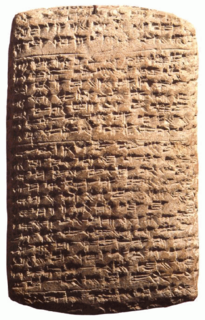
Rib-Hadda was king of Byblos during the mid fourteenth century BCE. He is the author of some sixty of the Amarna letters all to Akhenaten. His name is Akkadian in form and may invoke the Northwest Semitic god Hadad, though his letters invoke only Ba'alat Gubla, the "Lady of Byblos".
DU–Teššup was the son of Aziru, of the 1350–1335 BC Amarna letters correspondence, and also the father of Aziru's successor, in Amurru. DU-Teššup's name refers to the Hurrian god of sky and storm, Teshub.
Tutu was one of pharaoh's officials during the Amarna letters period 1350–1335 BC. He is only found in the body of letters from Aziru, and his son, DU-Teššup. Four of the Amarna letters—EA 158, 164, 167 and 169—are addressed to the Pharaoh, by way of Tutu. DU-Teššup's single letter is written to pharaoh because his father Aziru is being detained in Egypt, and Aziru is needed to attend to affairs at home. Unless he were to remarry he may never return home again.

Pawura, and also: Pauru, Piwure, Puuru/Puwuru was an Egyptian official of the 1350–1335 BC Amarna letters correspondence. As mentioned in letter no. 171, he was also an Egyptian "archer–commander". In letter no. 289 he is called an "irpi–official". In Egyptian his name means 'the Great One', (Pa-wr/Pa-ur)(letter EA 287:45-"1.-Pa-Ú-Ru")

Tunip was a city-state in western Syria in 1350–1335 BC, the period of the Amarna letters. The name "Syria" did not yet exist, though this was already the time of ancient Assyria. The regions were: Amurru, Nuhašše, the Amqu, Nii, etc.
Pirissi and Tulubri are a pair of messengers of the 1350–1335 BC Amarna letters correspondence. Pirissi and Tulubri are the messengers of King Tushratta of Mitanni, and are referenced in Amarna letters EA 27, 28, and EA 29,.
Abimilki around 1347 BC held the rank of Prince of Tyre, during the period of the Amarna letters correspondence. He is the author of ten letters to the Egyptian pharaoh, EA 146–155. In letter EA 147, Pharaoh Akhenaten confirmed him as ruler of Tyre upon the death of his father, and in EA 149, referred to him with the rank of rabisu (general).

Amarna letter EA 161, titled An Absence Explained, is a tall clay tablet letter of 8 paragraphs, with single paragraphing lines. The surface is somewhat degraded, but most cuneiform signs that remain, allow for a relative complete translation context for the letter, and the eight paragraphs. The clay tablet is no. BM 29818 at the British Museum; the number is visible at the top of the tablet, above Para I-(in black ink, the top half of the number visible).

Amarna letter EA 9 is a tall, compact 38 line clay tablet letter of 3 paragraphs, in pristine condition, with few flaws on the clay. The photo of the reverse (pictured) shows half of Paragraph III, and some of the signs.

Amarna letter EA 35, titled The Hand of Nergal, is a moderate length clay tablet letter from the king of Alashiya to the king (pharaoh) of Egypt. The letter has multiple short paragraphs, with scribed, single-lines showing the paragraphing. Paragraphs I-VII are on the letter's obverse; paragraph VIII starts at the bottom edge and continues, ending at Paragraph XIII on the clay tablet's reverse.

Amarna letter EA 86, titled: Complaint to an Official, is a somewhat moderate length clay tablet letter from Rib-Hadda of city-state Byblos to Amanappa, an official at the court of the Pharaoh.

Amarna letter EA 323, titled: A Royal Order for Glass, is a smaller, square, mostly flat clay tablet letter written on both sides, but only half of the reverse; it is also written on the bottom, and is a letter from 'governor' Yidya, and is a short letter like many of his other Amarna letters, numbered EA 320 to EA 326.

Amarna letter EA 149, titled: "Neither Water nor Wood" is a moderate- to extended-length clay tablet Amarna letter from Abimilku of Tyre-(called Ṣurru in the letters), written to the Pharaoh of Egypt.

Amarna letter EA 23, titled: "A Goddess Travels to Egypt", is a short letter to Pharaoh from Tushratta. Due to the ill health of Pharaoh, a statue of Goddess Šauška is being sent to Egypt, to aid in the health of Pharaoh.

Amarna letter EA 38, titled A Brotherly Quarrel, is a letter from the King of Alashiya. One identifier of many of the Amarna letters, is the use of paragraphing. Six paragraphs are in this letter, with much of the letter's reverse – uninscribed.

Amarna letter EA 39, titled: "Duty-Free", is a fairly short letter from the King of Alashiya. Almost half the letter, Para I, is a shortened greeting formula. The letter is requesting the Pharaoh to let messengers pass freely, as they are also being represented as merchants; this also applies to their shipping.

Amarna letter EA 59, titled: "From the Citizens of Tunip", is a short- to moderate-length clay tablet Amarna letter from the city-state of Tunip, written to the Pharaoh of Egypt. Only one other city sent a clay tablet Amarna letter to the Pharaoh, namely Irqata, letter EA 100, titled: "The City of Irqata to the King".

Amarna letter EA 156, titled: "Aziru of Amurru", is a very short letter from Aziru, the leader of the region of Amurru. EA 156 is the first letter in a series of 16 letters regarding Aziru.

Amarna letter EA 170, titled: "To Aziru in Egypt", is a moderate length letter, from Aziru, the leader of the region of Amurru. EA 170 is the fifteenth letter in a series of 16 letters regarding Aziru.

Amarna letter EA 147, titled A Hymn to the Pharaoh, is a moderate length clay tablet Amarna letter from Abimilku of Tyre-(called Ṣurru in the Abimilku letters, and an island, until the time of Alexander the Great, 330 BC). The letter is a twin letter to EA 149, which is identical in length, and complexity, and EA 147 appears to precede EA 149.









